Choosing between framed vs. frameless cabinets is one of the most important decisions in kitchen design—impacting everything from durability and layout to style and storage.
When you’re helping a client select kitchen cabinets, one of the first decisions is framed vs. frameless cabinet construction. While homeowners often focus on color and style, you know construction matters just as much—especially when it affects fit, function, and long-term satisfaction.
No matter if you recommend framed or frameless construction, the choice will affect how many cabinets can be fitted in the new kitchen, how much can be fitted in the cabinets, how long they will last and the style options.
Because kitchen cabinets typically represent the largest expense in a remodel, understanding the differences between framed vs. frameless cabinets is essential. This choice affects layout flexibility, interior access, installation methods, and available style options—making it a key factor in both design and function.
Start with the Fundamentals – Cabinet Construction
Cabinet construction falls into two categories: framed and frameless. Each has its own advantages and disadvantages, and both provide design possibilities.
What are the differences between framed and frameless cabinetry? Further, what are the advantages and disadvantages of each? In addition, why does it matter which one is chosen? How can you help your clients decide?
Here’s a side-by-side breakdown designed for professionals who need a clear, no-nonsense reference when specifying cabinets.
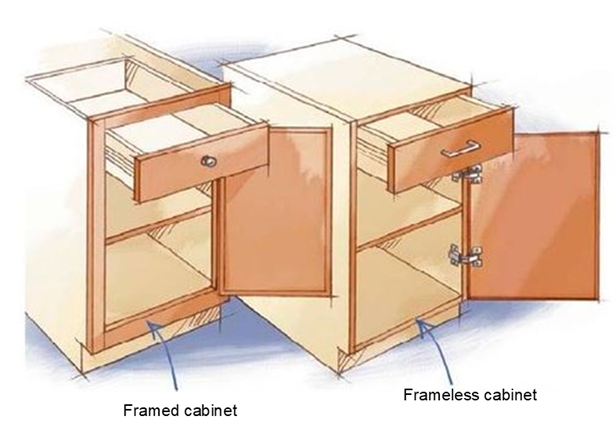
Framed Cabinets
Framed cabinet construction is an American tradition, and sometimes it’s called “American style”.
Just as the name suggests, framed cabinets have a face frame that is attached to and covers the front of the cabinet box, as you can see in the illustration above.
The actual face frame is made up of two horizontal pieces of solid hard wood that are 1-1/2″ wide and 3/4″ thick, called rails, and two vertical pieces, also 1-1/2″ wide and 3/4″ thick – called stiles. This frame looks like a picture frame.
Framed cabinets have been around for generations, and they will continue to be built for many more. And there are good reasons.
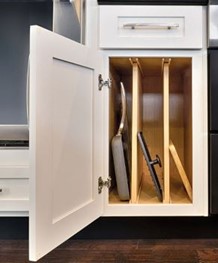
- They create a classic look familiar to us Americans. We like to see wood when we open the cabinet door.
- They are very sturdy because the frame provides a flat, strong area to hang the cabinet doors. The hinges are solidly attached to the hardwood face frame.
- The frame prevents the cabinet from getting “out of square”. If the cabinet does not stay square, i.e., keep its 90-degree amngles sharp and true, doors will stick and drawers may not open properly.
- When compared to frameless cabinets, framed cabinets provide more sizes and modification options.
More Info About Framed Cabinets
Since framed cabinets can accept any type of door and drawer front, they offer lots of style flexibility. They the doors and drawers are attached to the face frame creates different looks:
In partial overlay, the face frame can be seen between the doors and drawers.
In full overlay, the doors and drawer fronts cover the frame completely. You only see it when you open the doors and/or drawers. Full overlay can be used in both traditional and transitional styles.
In inset, the doors and drawers fit inside the face frame. When you look at a run of cabinets, the doors, drawers and face frame form a smooth, flat surface.
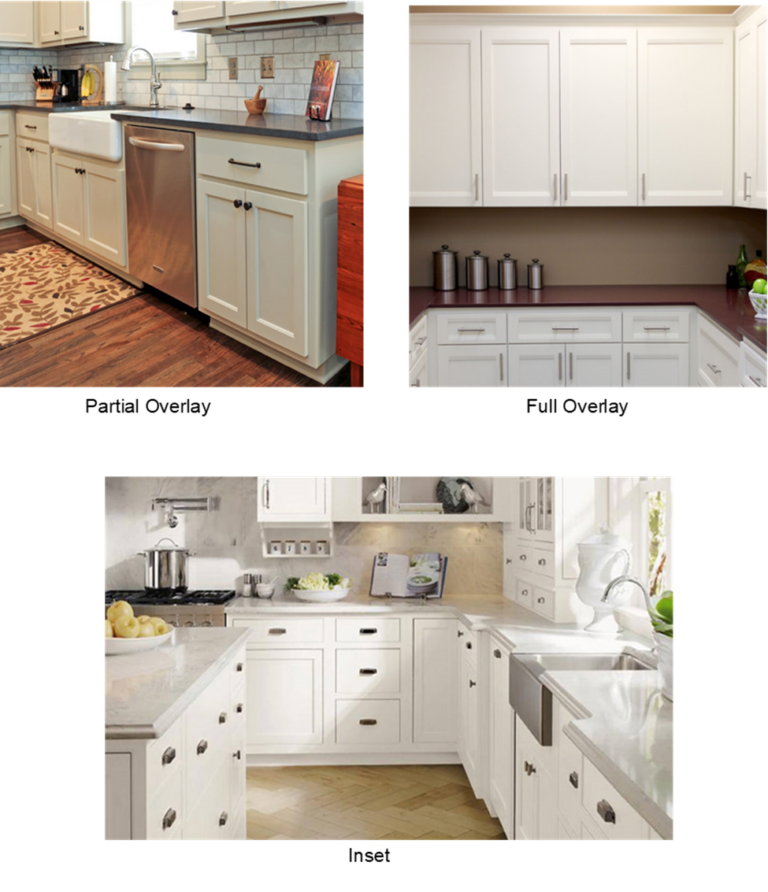
Disadvantages of Framed Cabinets
Nothing is perfect, right? Framed cabinets have a few disadvantages, but very few.
- The frame forms a slight “lip” inside the cabinet that some people don’t like and consider it as an obstacle. If you want to be able to slide your plates out of the cabinet without lifting them, then you will not like the “lip”. But most people don’t notice it because we’re used to seeing it. In high end custom cabinetry, the “lip” s removed by sanding it down.
- Drawers have 1-1/2” less interior space than the drawers in a frameless cabinet because of the frame.
What is Frameless Cabinet Construction?
Frameless cabinets—also known as European-style or Euro-style cabinets—offer a modern alternative to traditional framed construction. As the name implies, frameless cabinets are built without a face frame. Instead, the cabinet doors attach directly to the cabinet box, creating a clean, seamless front.
This construction method is often referred to as “full access” cabinetry because the absence of a face frame allows for more usable interior space and easier access to the contents. With no horizontal or vertical framing in the way, shelves and drawers can extend farther, maximizing storage.
Frameless cabinets have become increasingly popular among homeowners seeking a contemporary or minimalist kitchen design, but the benefits go beyond looks—greater interior capacity and a streamlined installation process make them a practical option as well.
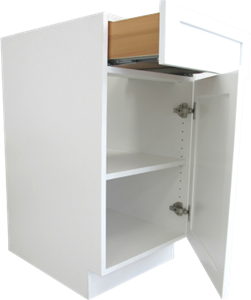
Advantages of Frameless Cabinets
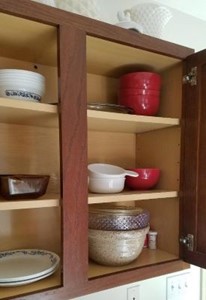
- There is more storage space. Without a face frame around the cabinet openings, it is easier to store large appliances such as food processors, juicers, coffee makers and/or blenders.
- Frameless cabinets provide a contemporary, smooth look because the edges of doors and drawers come up against each other nearly flush (in cabinet terms, they “butt”).
- You can omit the doors and have open shelves inside the cabinet. Since there’s no frame around the cabinet openings, the doors can be left off completely to provide open shelf storage.
- Frameless cabinets don’t have a center stile coming down in the middle of the two cabinet doors, providing easier access to the items inside, as well as more storage space. (See photo left) (In fairness to framed cabinets, cabinets less than 36” wide don’t get a center stile, either.)
- Drawers in frameless cabinets are slightly larger because of the space saved by not having a face frame attached to the front.
- Doors can easily be removed for cleaning without using tools. All you have to do is push the quick release button on the back of the door hinge.
- Flush exterior sides are standard on every frameless cabinet, while they are an upgrade on framed cabinets.
- In tight spaces (e.g., galley kitchens or small condos), frameless cabinets can offer better access when every inch matters.
Disadvantages of Frameless Cabinets
- Hinges can be unreliable. They are mounted to the sides of the cabinet that are often made from MDF, as opposed to the hardwood frames of framed cabinets. These hinges may need adjusted constantly to keep the doors straight and the cabinet fronts looking symmetrical.
- Frameless cabinets tend to be less durable than framed cabinets because the cabinet door is hinged directly to the cabinet box. In framed cabinets, hinges are attached to the solid wood cabinet face.
- When frameless cabinets get installed in older homes where you have uneven walls or floors, they may not fit properly. Door and hinge adjustments will be necessary to get the cabinets lined up and fitted properly.
- Frameless cabinets have less options in sizes and modifications.
- Because there’s no frame, there’s less lateral or horizontal strength. And less horizontal strength means frameless cabinets are not well suited for wider cabinets. The weight of items stored inside can actually warp the cabinet.
- Installers may charge more to install them because of the adjustments needed for a perfect fit.
- Design choices are limited to full overlay doors only, since the doors can only be mounted to the sides of the box and must cover the entire opening.
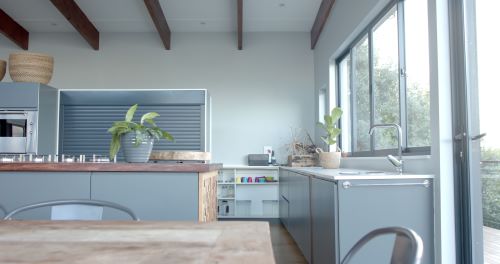
Conclusion
In the final analysis, the choice between framed and frameless cabinetry comes down to your client’s personal preference and the style they want. The main difference between framed and frameless cabinets is the box construction; you simply have two different construction methods that offer two different looks.
Framed cabinets are the best choice for a traditional look, with decorative hinges, and flexibility for door and drawer options (inset, partial-overlay, or full-overlay).
Frameless cabinets are a better option for smaller kitchens where every inch of space is needed. They offer a modern look, more drawer and cabinet space, and no center stiles that get in the way.
Bob Aungst Cabinet Sales is a full-service rep agency with the goal of matching kitchen designers and remodelers with the cabinet manufacturers best suited to their business’ style and clientele. Owner Bob Aungst III represents Brighton Cabinetry, US Cabinet Depot, Integrity Cabinets and StyleCraft Luxury Custom Cabinets.
